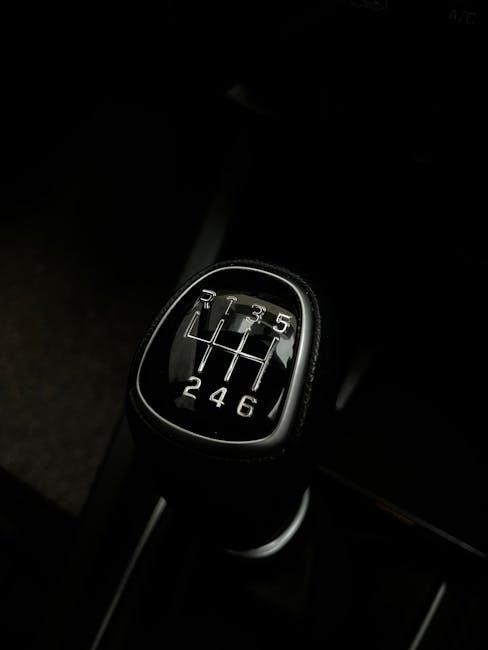The Ford 3-Speed manual transmission‚ known as the 3.03‚ was introduced in 1963 as the Toploader‚ featuring a fully synchronized design for smooth shifting and durability.
1.1 Overview of the Ford 3-Speed Manual Transmission
The Ford 3-Speed manual transmission‚ also known as the 3.03‚ is a three-speed‚ rear-wheel-drive transmission introduced in 1963. It features a fully synchronized design for smooth shifting and durability. Widely used in Ford trucks (F-100 to F-250) and cars like the Galaxie and Fairlane‚ it became a standard option until modern transmissions replaced it.
1.2 Historical Significance and Popularity
The Ford 3-Speed manual transmission holds significant historical value‚ tracing back to the Model T’s early 20th-century roots. Its simplicity and durability made it a staple in Ford vehicles throughout the mid-20th century‚ particularly in trucks and muscle cars. It remained popular for its reliability and ease of use‚ embodying Ford’s engineering prowess.
1.3 Applications in Ford Vehicles
The Ford 3-Speed manual transmission was widely used in various Ford models‚ including the F-100 to F-250 trucks‚ Mustang‚ Falcon‚ and Broncos. It was also featured in utility vehicles‚ showcasing its versatility across different vehicle types and purposes‚ from work trucks to performance cars‚ making it a versatile and reliable option for Ford drivers.

History and Development of the 3-Speed Manual Transmission
The Ford 3-Speed manual transmission traces its roots to the Model T‚ with the first 3-Speed appearing in the early 20th century. Over the decades‚ it evolved‚ culminating in the Toploader design introduced in 1963‚ which became a staple in Ford vehicles‚ offering reliability and durability for various applications.
2.1 Early Beginnings: The Model T and the First 3-Speed
The Ford Model T introduced the first 3-Speed manual transmission in 1908‚ featuring a primitive yet innovative design with a floor-mounted shifter and clutch pedal. This setup laid the foundation for future transmissions‚ emphasizing simplicity and durability‚ which became hallmarks of Ford’s early automotive innovations.
2.2 Evolution Through the Decades
The Ford 3-Speed manual transmission evolved significantly over the decades‚ starting with the Model T’s primitive design. By the 1940s‚ synchronized gears were introduced‚ improving shifting smoothness. The 1960s saw the Toploader transmission‚ which became iconic for its durability and performance‚ solidifying the 3-Speed’s reputation as a reliable and enduring component.
In 1963‚ Ford introduced the Toploader transmission‚ a 3-Speed manual gearbox designed for durability and performance. It replaced the BorgWarner T-10‚ offering a robust‚ synchronized design with a distinctive top-mounted shifter. The Toploader became a staple in Ford vehicles‚ including the F-Series trucks and performance cars‚ known for its reliability and ease of maintenance.

Design and Mechanics of the Ford 3-Speed Transmission
The Ford 3-Speed features a fully synchronized‚ three-speed manual design with a top-mounted shifter. Its robust construction and gear ratios provide smooth shifting and reliable performance across various Ford vehicles.
3.1 Gear Ratios and Synchronization
The Ford 3-Speed manual transmission features a fully synchronized design‚ offering smooth gear transitions without double-clutching. The 3.03 model includes specific gear ratios optimized for performance and efficiency‚ ensuring reliable operation in various Ford vehicles‚ from trucks to performance cars like the Mustang.
3.2 The Toploader Design: Features and Benefits
The Toploader transmission‚ introduced by Ford in 1963‚ features a robust‚ compact design with a removable top cover for easy maintenance. Its fully synchronized gears and helical-cut design provide smooth shifting and reduced wear‚ making it a reliable choice for both on-road and off-road applications in Ford vehicles.
3.3 Key Components and Engineering
The Ford 3-Speed manual transmission features a durable‚ compact design with helical-cut gears for smooth operation. Key components include a removable top cover‚ iron or aluminum extension housing‚ and synchronized gears (except reverse). Its robust engineering ensures reliability and versatility for various applications‚ from trucks to performance vehicles.
Identification and Specifications
The Ford 3-Speed manual transmission is easily identified by its removable top cover and serialized markings. It features a durable‚ compact design with helical-cut gears and synchronized shifting.
4.1 Serial Numbers and Markings
Ford 3-Speed manual transmissions feature unique serial numbers and markings‚ such as HEF-BB‚ HEF-BF‚ and HEF-BG‚ which denote specific models and years. These codes‚ often stamped on the top cover‚ help identify the transmission type‚ application‚ and production details‚ aiding enthusiasts and restorers in verifying authenticity and compatibility with various Ford vehicles.
4.2 The 3.03 Transmission: Specifications and Applications
The Ford 3;03 3-Speed manual transmission‚ introduced in 1963‚ was widely used in F-100 to F-250 trucks and select passenger cars. Featuring a column-mounted shifter‚ it offered a simple‚ durable design with gear ratios suited for light-duty applications. This transmission became a staple in Ford’s lineup‚ providing reliable performance for decades.
4.3 How to Identify a Ford 3-Speed Transmission
Identify the Ford 3-Speed by its 3.03 designation‚ introduced in 1963. It features a Toploader design with an external gear shifter‚ fully synchronized gears (except reverse)‚ and a 4-bolt top cover. The extension housing can be iron or aluminum. Common in F-100 to F-250 trucks‚ Galaxies‚ Fairlanes‚ and early Broncos. Serial numbers and part codes like HEF-BB or HEF-BF confirm its identity.
Common Applications and Vehicles
The Ford 3-Speed manual transmission was widely used in F-100 to F-250 trucks‚ Mustangs‚ Falcons‚ and Broncos‚ making it a staple in both utility and performance vehicles.
5.1 The 3-Speed in Ford Trucks: F-100 to F-250
The Ford 3-Speed manual transmission was a popular choice for F-100 to F-250 trucks‚ known for its durability and simplicity; It featured a column-mounted shifter and was ideal for light-duty applications‚ providing reliable service in various work environments. This transmission became a staple in Ford’s truck lineup during its production run.
5.2 The 3-Speed in Ford Performance Cars: Mustang and Falcon
The Ford 3-Speed manual transmission was also featured in performance-oriented vehicles like the Mustang and Falcon. It provided a cost-effective‚ lightweight option for drivers seeking a sporty feel without the expense of a four-speed. This gearbox was particularly popular among budget-conscious buyers who prioritized affordability and simplicity in their driving experience.
5.3 The 3-Speed in Ford Broncos and Other Utility Vehicles
The Ford 3-Speed manual transmission was utilized in Ford Broncos and other utility vehicles‚ offering durability and simplicity. It featured a fully synchronized design‚ making it suitable for both on-road and off-road applications. This transmission was commonly paired with V8 engines‚ providing reliable performance in rugged conditions and lightweight utility vehicles.

Maintenance‚ Repair‚ and Troubleshooting
Regular maintenance involves checking fluid levels and inspecting for leaks. Common issues include worn synchromesh and seal leaks. Rebuilding requires specialized tools‚ while diagnostics focus on identifying gear engagement problems.
6.1 Common Issues and Maintenance Tips
Common issues with the Ford 3-Speed include worn synchronizers‚ seal leaks‚ and gear engagement problems. Regular fluid checks and gasket inspections are essential. Lubricate gears periodically and replace worn bearings. Addressing these issues early prevents costly repairs and ensures smooth transmission operation. Proper maintenance extends the lifespan of the transmission significantly.
6.2 Rebuilding and Restoring the 3-Speed Transmission
Rebuilding the Ford 3-Speed involves disassembling‚ inspecting‚ and replacing worn components like bearings and seals. Use specialized tools for gear removal and alignment. The Toploader design simplifies rebuilding due to its modular construction. Ensure all parts are cleaned and lubricated before reassembly. Consult a detailed manual for precise torque specifications and tolerances.
6.3 Diagnostic Techniques for the 3-Speed
Diagnosing the Ford 3-Speed involves checking for leaks‚ unusual noises‚ and inconsistent gear engagement. Use a scan tool to identify trouble codes if equipped. Inspect the clutch and linkage for wear. Listen for grinding or whining sounds during shifting. Test gear ratios manually to ensure proper function. Consult a service manual for detailed troubleshooting steps.

Upgrades and Modifications
Enhance the Ford 3-Speed with performance upgrades like gear ratio changes and aftermarket shifters. Install lightweight components for better efficiency. Modernize with overdrive kits for improved highway performance and fuel economy.
7.1 Performance Upgrades for the 3-Speed
Performance upgrades for the Ford 3-Speed include installing lightweight components and aftermarket shifters for quicker shifts. Adding a performance clutch kit enhances engagement precision. Modified gear ratios optimize acceleration and top-end speed. Upgraded synchronizers improve shifting smoothness and durability for high-performance driving applications without compromising the transmission’s reliability and classic functionality.
7.2 Adapting the 3-Speed to Modern Vehicles
Adapting the Ford 3-Speed to modern vehicles involves custom fabrication‚ such as adapter plates and crossmembers‚ to ensure compatibility with contemporary engines and electronics. The Toploader’s durable design allows it to pair well with modern powertrains‚ blending classic shifting feel with improved performance capabilities in today’s automotive applications.
7.3 Customization and Aftermarket Parts
The Ford 3-Speed transmission can be customized with aftermarket parts‚ including gear sets and shift kits‚ to enhance performance. Enthusiasts often modify the Toploader for better durability and compatibility with modern engines. Specialist companies offer rebuilt units‚ adapter plates‚ and custom mounts‚ making it easier to install in various vehicles while maintaining its classic appeal.

The Future of Manual Transmissions at Ford
Ford continues to phase out manual transmissions in modern vehicles‚ yet models like the Bronco and Mustang still offer 6-speed manuals‚ preserving driver engagement and heritage.
8.1 Decline of Manual Transmissions in Modern Ford Vehicles
The demand for manual transmissions has significantly decreased in Ford’s modern lineup‚ with most models transitioning to automatic or dual-clutch options. This shift reflects consumer preferences for convenience and technology‚ leading Ford to discontinue manual options in many vehicles‚ except for select performance models like the Mustang and Bronco.
8.2 Current Models Still Offering Manual Options
Ford continues to offer manual transmissions in select models‚ such as the Mustang and Bronco‚ catering to enthusiast demand. These modern manuals‚ like the 6-speed in the Bronco‚ provide a blend of performance and driver engagement‚ ensuring that the manual tradition remains alive in Ford’s lineup despite broader industry trends toward automation.
8.3 The Role of the 3-Speed in Ford’s Heritage
The Ford 3-Speed manual transmission holds a significant place in the company’s heritage‚ symbolizing simplicity and durability; Introduced in the Model T‚ it evolved into the Toploader‚ becoming iconic in classic models like the Mustang and Bronco. Its enduring appeal has made it a cherished component of Ford’s automotive legacy and identity.

Collectibility and Restoration
The Ford 3-Speed manual transmission is highly collectible‚ sought after for its durability and iconic status in classic vehicles. Restoration involves sourcing rare parts and expert rebuilding to maintain its heritage value.
9.1 The 3-Speed Transmission as a Collector’s Item
The Ford 3-Speed manual transmission is a prized collector’s item‚ especially the Toploader model‚ due to its historical significance and durability. Enthusiasts seek these transmissions for classic car restorations‚ valuing their mechanical simplicity and nostalgic appeal. Rare models and complete units with original markings command high prices among vintage automotive enthusiasts and restorers.
9.2 Restoration Tips and Parts Availability
Restoring a Ford 3-Speed transmission involves sourcing genuine parts like bearings‚ gaskets‚ and gearsets. Many components are still available through Ford’s parts catalog or aftermarket suppliers. Detailed manuals and online forums provide step-by-step guidance‚ making the restoration process accessible for enthusiasts. Rebuilding requires precision to ensure proper gear engagement and smooth operation.
9.3 The Community and Market for Classic Transmissions
The Ford 3-Speed transmission has a dedicated enthusiast community‚ with active forums and clubs preserving its legacy. Specialized shops and online marketplaces offer rare parts‚ supporting restorers and collectors. Classic car shows and auctions often feature these transmissions‚ showcasing their enduring appeal and historical significance in automotive culture.
The Ford 3-Speed manual transmission stands as a testament to simplicity and durability‚ leaving a lasting legacy in automotive history while remaining a popular choice among classic car enthusiasts.
10.1 Summary of the Ford 3-Speed Manual Transmission
The Ford 3-Speed manual transmission‚ introduced in 1963 as the Toploader‚ is renowned for its durability and simplicity. Used in various Ford vehicles until 1986‚ it features a fully synchronized design‚ except for reverse gear‚ making it a reliable choice for both everyday driving and classic car enthusiasts.
10.2 Its Legacy in Automotive History
The Ford 3-Speed manual transmission holds a significant place in automotive history‚ symbolizing simplicity and reliability; Its introduction in 1963 marked a shift towards synchronized gears‚ enhancing driver experience. Popular in Ford trucks‚ Broncos‚ and Mustangs‚ it remains a cherished component among classic car enthusiasts‚ embodying the essence of timeless mechanical design.
10.3 Final Thoughts on the 3-Speed’s Impact
The Ford 3-Speed manual transmission left an indelible mark on automotive history‚ offering reliability and simplicity. Its widespread use in Ford vehicles like the Mustang and F-Series trucks highlights its practicality. Today‚ it remains a favorite among restorers and enthusiasts‚ symbolizing a bygone era of straightforward‚ durable engineering in automotive design.

